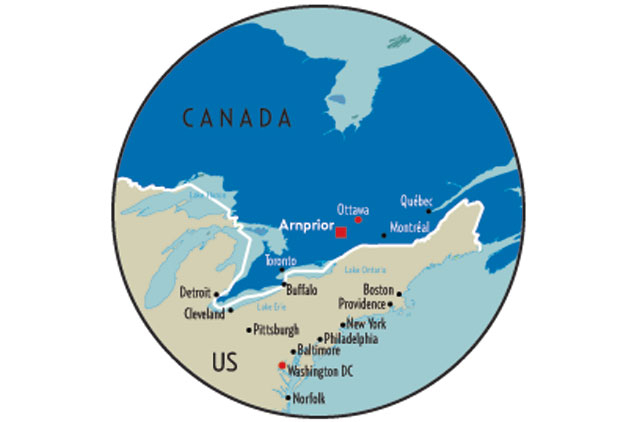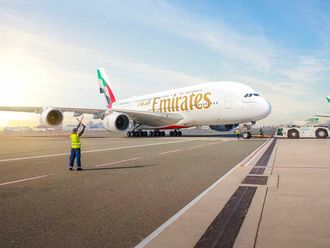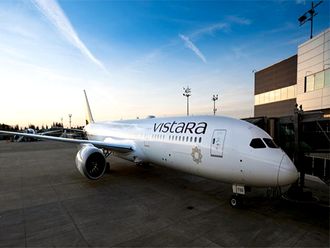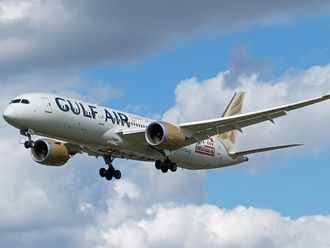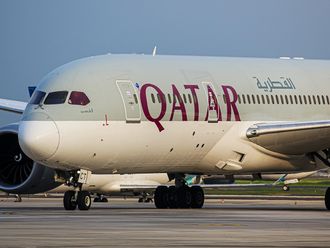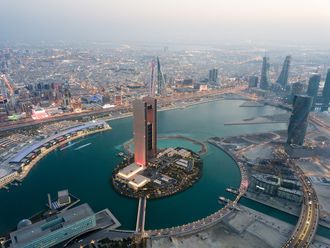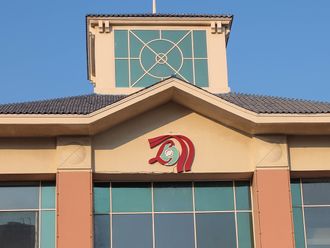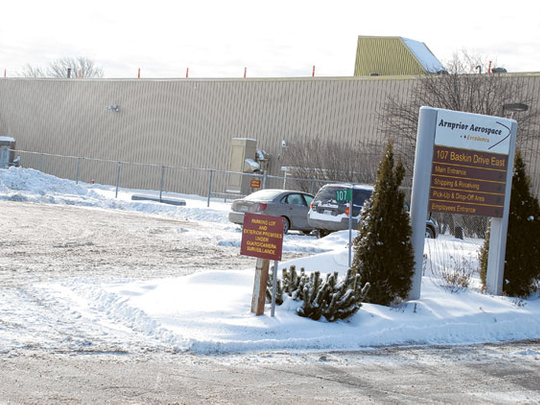
Arnprior is the kind of small town seemingly far removed from the trials and tribulations of the international aviation industry.
It's off the beaten track, nestled sleepily in the Ottawa Valley and nearly straddles the river border between Ontario and Quebec. The ferry across the Ottawa River runs April through to November, a signpost on Highway 417 warns, along with another that warns to drive according to weather conditions. Winters are long, the snow deep and the cold crisp and biting.
You don't have to drive down the main street of Arnprior, population 7,500, to get to the huge plane-parts manufacturing plant on the outskirts of town, but if you do, you get a good picture of what Arnprior Aerospace means here.
Penny and Syd Gravel have been running Penny's Fudge Factory since 1989 in a renovated store that had been a landmark near the Chats Falls Dam. Their website proudly proclaims that "people from all over, as far away as Moscow, Russia, Yellowknife NWT and Pretoria, South Africa have tasted and still call upon Judy to ship them some of her famous fudge."
At McAllister's Ford, a heavy duty 2006 F150 crewcab pickup truck will set you back $19,449 (Dh71,377) for a 4X4 drive, a hitch package and running boards, perfect for your snowmobiles. And financing is easy, as long as you have a job, and your credit isn't bruised — make an offer and drive her off the lot with no money down.
Down Elgin Street West, Jim's Restaurant is doing a brisk mid-morning trade in eggs over easy, homefries, toast and endless cups of coffee.
Spiros, George and John Karakadis have made a comfortable living and the morning shift at Arnprior Aerospace just down the street and across Highway 417 have certainly contributed to their bottom line.
Same with McAllister Ford. And even Penny's Fudge Factory.
Contributions
In fact, "the Aero," as the locals call it, is pretty much the biggest and only game in this small town. Some 480 families in the town and up the Ottawa Valley as far as Eganville and Cobden and Kanata, any community within a 75 kilometres radius on the Ontario side of the border, draw paycheques from the plant. Not so Quebec because, after all, the ferry only runs April through to November.
"Arnprior Aerospace has contributed to our community over the past five years," says Zillan Briscoe, an attentive neatly dressed middle-aged woman who's a senior banking officer at Scotiabank.
She's also the president of the Greater Arnprior Chamber of Commerce, listens attentively and moves her lips repeating in silence every word this writer says, careful not to miss any detail.
Arnprior Aerospace is the manufacturer of cargo doors, wiring support racks, flooring jigs, shelves, trays and a whole host of other parts that need specialised chemical and manufacturing processes for Boeing and other defence contractors. But mostly Boeing, and mostly for the new 777s.
Between them, Emirates and Etihad fly nearly 170 long-rang Boeing 777s in their fleets, and have options and orders in for another 145 more — enough work to keep the 480 families depending on the Aero in hockey skates, food bills, mortgage payments and heavy duty Ford F150 crewcabs for the next decade. And more.
Since 1953, the plant has been working in one form or another; first it was known as Piasaki, then Vertol. It became Boeing Vertol and made most of the components for the twin-rotor heavy lift Chinook helicopters, so vital in the paddy fields of Vietnam, the wadis of Iraq during both Gulf Wars, and for airlifting troops quickly into Taliban-held areas in Afghanistan. The plant, known as Boeing of Canada Technology kept production going with as few as 300 employees, but it finally was sold to Arnprior Aerospace in 2005.
Whatever its history, its economics have benefited the Greater Arnprior community for decades.
In Ontario, nearly 30 per cent of all parts for the Boeing 777 are manufactured, sent to Boeing factories in the US for final installation.
Landing gear comes from Ajax, just outside Toronto, stowage bins, fuselage components, wiring harnesses, from companies like Arnprior Aerospace, CMC Electronics and Composites Atlantic. Boeing has at least two other major suppliers in the Ottawa area.
At Scotiabank, Briscoe prints out a speech she recently gave about the importance of Arnprior Aerospace; the plant was been nominated in the Big Business category of the chamber's annual awards.
It's hard to see who their opposition is the category is — maybe Pillar 5 Pharma, with nearly 100 employees, maybe the Ontario Generation Plant, one of a series of five that produces electricity from the Madawaska River.
The Aero has contributed to Arnprior's Partners in Caring programme, wrote cheques and participated in Heart and Stroke Society fund-raising and activities, provided scholarship funds for local schools, matched its employee donations dollar for dollar for the Haiti Relief Fund, participated in local business groups, and supported the Arnprior District High School Design Challenge and the annual gift a share.
"I never knew Emirates and Etihad had so many 777s," Briscoe says. "That's news. So why aren't the Canadian government letting them fly in more. That's a lot of planes," Briscoe says.
She's likely going to raise the issue at the Greater Arnprior Chamber of Commerce.
At the offices of the weekly Arnprior-Chronicle Guide, the editor isn't there. Neither are the two reporters. News must be breaking somewhere among the snow-covered cornfields and heavily wooded farms of Arnprior and the surrounding areas.
"Maybe I can help you?" offers Leslie Osbourne, an advertising consultant. She, as it turns out, worked at the Aero for 11 years as a chemical production technician, making sure the components for Emirates' and Etihad's Boeing 777s were properly treated. She's energetic and efficient, a good ambassador for Arnprior and an even better one for the weekly that has served the town and the surrounding areas since 1879. Her cousin is a golf pro who has worked in Dubai and is now moving to Abu Dhabi. She'd love to visit him some time.
"But it must be very expensive to fly there," she offers, half question, half statement. She'll keep in touch through Facebook for now.
She prints out the latest list of members of the Greater Arnprior Chamber of Commerce; McAllister Ford is a member, So too Doug Smith's Citadel Crafts, Terry Wright's Budget Propane, Len Stevenow's Valley Rent Rite, Barb Clarke's Elegant Drapery and Accessories.
Not a part of it
And Arnprior Aerospace. Penny's Fudge Factory, however, isn't a member for 2011.
"Yes, the plant means everything to the town," Osbourne says, sorting the printed sheets into a neat stack. "It's the biggest employer and it had as many as 600 working there one time. It went down to 300, but it's now back to 480 and there are lots of orders.
Lots of orders for Emirates and Etihad planes.
"Oh, I didn't know that," she says. "So why can't they fly in here more?" Good question. As it stands right now, the Canadian government is allowing only Emirates and Etihad three landing slots each per week at Toronto. If both UAE carriers had their way, they'd fly their Boeing 777s or Airbus A380s into Toronto daily, along with other flights to Montreal, Calgary and Vancouver. "The plant contributes a lot to the town, they even sponsor junior hockey teams," Osborne notes, citing the most basic mantra of corporate charity work in Canada: support hockey, hockey and hockey.
In the hard-packed snow and icy parking lot of Arnprior Aerospace, the heavy duty pickup trucks and family minivans stand cold as their the morning shift owners are busy at work. A couple have snow mobiles in the back bins, another with a bumper sticker supporting the Arnprior Packers, "the oldest and most beloved team in the Eastern Ontario Junior B Hockey League."
Home crowd
The home crowd can get up to a couple of hundred, depending on the opposition at the Nick Smith Memorial Arena, sometimes double that if local rivals the Renfrew Timbervolves are visiting.
But there's rarely ever as many as working the lines at the Aero now.
According to Osbourne, Murray Quattrocchi "is a good guy." He used to work in management at the plant, but is now the union president for the International Association of Machinists and Aerospace Workers.
But Quattrocchi won't comment.
That's troubling, because the speculation at Jim's Restaurant is that there's a low level but constant fear the Aero will fold shop completely and move to Mexico.
The company line is that Arnprior has too many contracts in Canada to do that, and the work there is more sophisticated than can be done down there.
Arnprior Aerospace has a new 75,000 square foot factory in Chihuahua, Mexico.
The site produces metallic components and assemblies and helps the Arnprior site in Canada "enhance its overall value proposition through incorporation into complex, high value offerings," the company says.
The real fear, though, is that the town's high-paying jobs will move to Mexico. To the south east, Smiths Falls used to be the proud home of Hershey, the chocolate maker.
But then Smith Fall's biggest employer closed up shop an moved production to Monterrey, Mexico at the end of 2007. That was a devastating blow that meant the loss of 800 jobs.
At Arnprior Aerospace, however, the company line is clear.
"Arnprior Aerospace is a proud supplier of products for Boeing Commercial Airplanes as well as several other key aerospace equipment manufacturers," Tom Melvin, the vice-president of operations and general manager says. Beyond that, Melvin, who has been at the plant since 1982, has little to say.
"I will not comment on [any] hypothetical potential economic impact of the specific airline situation you have referenced," he says. And that is the end of conversation from the plant.
Maybe some of Penny's fudge will sweeten him up.
777 facts
- Since the first 777 entered service in June 1995, the airplane has flown almost five million flights and accumulated more than 18 million flight hours.
- There are 3 million parts in a 777 provided by 500 suppliers from around the world.
- In 2009, the 777 programme delivered its 777th 777.
- On November 9-10, 2005, a Boeing 777-200LR Worldliner set a new world record for distance travelled non-stop by a commercial jetliner. The 777-200LR set a record distance of 11,664 nautical miles (21,601km) on a route travelling eastbound from Hong Kong to London (Heathrow). The flight lasted 22 hours and 42 minutes. The achievement was recognised by the US National Aeronautics Association, The Fédération Aéronautique Internationale and the Guinness Book of Records.
- On May 30, 1995, the 777 became the first airplane in aviation history to earn US Federal Aviation Administration (FAA) approval to fly extended-range twin-engine operations (ETOPS) at entry into service. On that date, the FAA awarded 180-minute ETOPS to the Pratt & Whitney-powered Boeing 777.
- The 777 is capable of cruising at altitudes up to 43,100 feet.
- Boeing engineers designed and electronically pre-assembled the 777 using computers. New laboratory facilities enabled the various airplane systems to be tested together as a single integrated entity in simulated flight conditions, before the first jetliner took to the air.
- The data shared and transferred on the network during the design phase of the 777 programme totalled 1,847,930,000,000 bytes of production data.
- Today’s 777 operators enjoy a 99.3 per cent dispatch reliability rate — the highest amongst all twin-aisle airplanes in service today.
- The flight-control system for the 777 airplane is different from those on other Boeing airplane designs. Rather than have the airplane rely on cables to move the ailerons, elevator, and rudder, Boeing designed the 777 with fly-by-wire technology. As a result, the 777 uses wires to carry electrical signals from the pilot control wheel, column, and pedals to a primary flight computer.
- A lightly loaded 777 can accelerate from zero to 60 mph (96 km/h) in less than six seconds.
Source: Boeing


